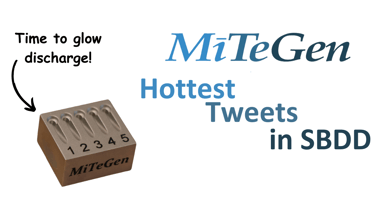Introducing the Hottest Tweets in SBDD sponsored by MiTeGen, your curated source of recent tweets...
How long can dry shippers let your protein and cooler heads prevail when stuck in transport?
One annoying challenge that researchers and biotech companies encounter regularly is the safe and efficient shipping of delicate, cryogenically frozen samples such as proteins or cryo-EM grids. This task becomes more daunting in light of recent global disruptions like pandemics, and political shifts that impact country borders. And as we advance in the democratization through decentralization of cryo-EM access, a concept explored in a previous post with the possibilities of IoT cryo-EM, the significance of good logistics becomes increasingly paramount. So, how can we ensure the safe transit of these precious cargo, especially when the conventional courier services may not be specialized for such tasks?

Benefits of dry shippers over dry ice for protein and grid transport
Historically, proteins have been shipped frozen using dry ice, with specialized couriers offering dry ice replenishment and safe delivery services. However, these services come at a significantly higher cost, and whilst this method is suitable for proteins, it is not at all fit for transporting frozen grids.
Personally, I favor shipping protein vials in a dry shipper. This preference arises from the fact that it permits the shipping of both, frozen grids and proteins, allowing immediate access to the microscope with the grids. There's an added reassurance that, should there be an issue with the grids due to inadequate handling, the protein is available as a backup. Moreover, the option to revisit vitrification is always useful. But even when my shipping requirement is exclusively protein, I still lean towards the use of a dry shipper.
Comfortable cooling duration in the face of shipping delays
The only question that arises is whether to utilize a boutique courier service for the dry shipper, which can be costly, or a general courier service, which isn't necessarily optimized for the demands of cryo-EM samples. My primary concern centers around the possibility of a package being stuck somewhere during transport or being delayed in customs, thereby putting both, the grids and protein, at risk. This is especially relevant for long-distance international shipments.
To gain a better understanding of dry shipper performance, specifically their cooling duration to keep proteins frozen during transit, I reached out to MiTeGen. They are well-known for their specialized equipment (e.g. shipping cases, grid boxes, pucks, shelved transport cane for pucks as well as tracking and identification options) for shipping samples, whether it is frozen grids or vials of proteins. My question was simple: In the event of a shipping delay, how long could a dry shipper maintain its cooling capacity before the protein samples are compromised? MiTeGen kindly shared a warming plot for the IC Biomedical CX-100 model, revealing an impressive ability to keep proteins frozen for a solid 23 days. This exceeds the manufacturer's conservative specifications of 18 static days and 12.6 working days for preserving samples at cryogenic temperatures. Considering the substantial cost associated with dry ice shipments, the comparatively low cost of shipping a dry shipper as a standard package becomes very attractive. And, with a cushion of about three weeks, there's ample buffer for potential hiccups during transport.
Embracing the synchrotron model with comprehensive starter kits
Efficient logistical solutions like the IC Biomedical CXR-100 are key to fully unlocking the potential of IoT cryo-EM and a decentralized access model akin to the synchrotron model in crystallography. And this is where MiTeGen has you covered. They offer not just standalone dry shippers but also convenient packages that that include dry shippers (e.g. MiTeGen Cryo-EM Grid Storage and Shipping Puck Systems or MiTeGen Cryo-EM Starter Kits).
These bundles are well thought out, comprehensive packages that equip a lab with all the necessary tools to start creating their own samples and subsequently ship them to cryo-EM facilities for imaging. The starter kit bundles include a dry shipper like the Taylor Wharton CXR-100, along with other essentials for preparing cryo-EM grids, making it a complete solution for those beginning their journey in the world of cryo-EM.
This is the future of cryo-EM - more connected, more accessible, and closer than ever before.
Useful links
- MiTeGen Dry Shippers (CX100, CXR100, CXR500)
- MiTeGen Cryo-EM Grid Storage and Shipping Puck Systems
- MiTeGen Cryo-EM Starter Kits




